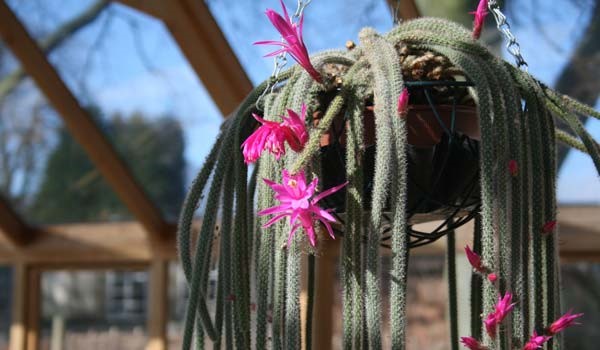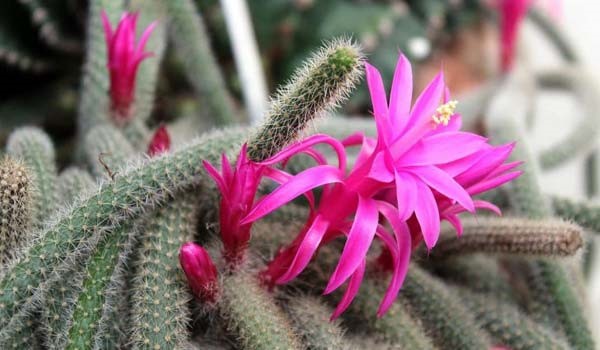Growing Rat Tail Cactus + Common Problems

There are many cacti with whimsical shapes, and the rat tail cactus is another one. When looking at this plant, its long and trailing stems will make think of a rat tail that can grow up to 4 feet. Scientifically called Aporocactus flagelliformis, this plant is from Mexico and some parts of Central America.
The rat tail cactus an epiphytic plant, meaning that it can grow in places with low soil such as rocky crevasses, ground, or on trees. Because of the characteristics of its stems, people usually prefer growing rat tail cactus cuttings in hanging pots.
Aporocactus flagelliformis has many varieties. In case that you are interested in buying them, or you want to propagate rat tail cactus seeds and watch it grow and bloom, you will find all the information you need below.
Rat Tail Cactus Flower
When growing a cactus, seeing it bloom and produce flowers is one of the joys that few can understand. If you are growing your specimen outdoors, and you are patient enough to wait for at least a few years, there is a good chance that you will be graced by rat tail cactus flowers.
Aporocactus flagelliformis mature stems rarely produce bright pink or red tube-shaped flowers about 2 or even inches (5 to 7.5 cm) wide in the late spring and early summer for a few days.
When growing it indoors, if you successfully repot your plant every year and feed it very well, there is a good chance that the rat tail cactus bloom.
How to Grow Rat Tail Cactus Cuttings
Propagating this succulent by cuttings is fairly convenient since its stems grow quickly. This is a drought-tolerant plant that can survive with little care and attention. So for caring young or mature Aporocactus flagelliformis, simply keep the following tips in mind:
Soil
Your rat tail cactus needs rich and well-draining soil that is gritty for the best grow; similar to other succulents. An organic potting mix will work just fine. For the perfect potting soil, we recommend mixing one part sand, four parts of loam, and one part vermicompost. You can also line the pot with organic materials like sphagnum moss for even better growth.
Water
In the growing season, water your rat tail cactus cuttings regularly for keeping its soil rather moist. As you get closer to fall, reduce the irrigation and stop completely in the winter. However, if the soil is completely dry during the dormancy period, water it lightly. You will not need to do this more than twice during the winter.

Light
The rat tail cactus needs full sunlight to thrive best. Make sure to place it in a spot with full and bright sunlight. We recommend the sunniest window in your home. If there is not such a spot available, use indoor LED plant lights to supplement the natural light that it can get.
If you can, it is a good idea to place its pot or hang its basket outdoors in summer for extra light and some fresh air.
Temperature
The temperatures between 45° F to 50° F are the best for Aporocactus flagelliformis. It is not frost-hardy; however, it can tolerate temperatures as high as 90° F.
During the summer, early autumn, and spring, the rat tail cactus can grow perfectly in room temperatures. But during the winter, you will need to provide a cooler place for it to survive later.
Feeding
Fertilizing can encourage producing rat tail cactus flowers and better growth. For feeding, use a diluted liquid cactus fertilizer every month in spring and summer. Dilute the fertilizer to a mild strength.
Repotting
The rat tail cactus grow rate is not very slow. So it is recommended to change its pot every year. Sometimes you may not need a new pot, but make sure to change the soil. Because this plant uses the nutrients in the soil quickly.

Propagating Rat Tail Cactus Seeds
As we mentioned before, propagating this plant using rat tail cactus cuttings is really easy and it can be done every season. All you need to do is to cut the tip of a stem off or cut a complete stem into pieces with a sharp and clean knife.
Let them dry for a few days (three days should be enough) so they form calluses and then poke them not more than an inch (2 cm) deep in rich soil. Provide a lot of sun and moisture, and after two or three weeks, your rat tail cactus cutting(s) will form roots.
Since watering is extremely crucial for seeds, water regularly for the first few weeks. So they do not die of dryness. Also, keep in mind that not all the seeds will germinate, just like in the wild and their natural habitat.
You can also grow rat tail cactus seeds. It is not specifically challenging, but you need to be patient. If you can get seeds from a rat tail cactus flower, make sure to purchase them from a reputable dealer.
Rat Tail Cactus Problems
There are a few problems that can hurt your Aporocactus flagelliformis. Here are the most important ones:
- Insects: Spider mites and scale insects puncture your houseplant to consume its juice. To get rid of these pests, apply insecticidal soap every few days for three weeks. Remember that extreme dryness can make your problem with spider mites worse.
- Snails: If you are growing your cactus outdoors, snails can be a problem. They will bite chunks of your plants; acting like there are no spikes. To prevent this problem, use a toxin that contains iron phosphate that dehydrates these creatures and makes them go away. Do not toxins that contain is metaldehyde, it can kill other animals like squirrels, birds, and even dogs.
- Root Rot: High humidity and over-watering can cause the stem and root of your rat tail cactus to rot.
- In this post:
- Rat Tail Cactus Flower
- How to Grow Rat Tail Cactus Cuttings
- Propagating Rat Tail Cactus Seeds
- Rat Tail Cactus Problems



